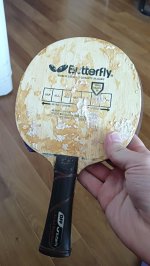Guaranteed ways to get rubber shrinkage after mounting your rubber:
1. Boosting your rubbers yourself.
Booster is just a solvent for one or more of the various natural polymers that partially make up your rubber. The rubber gets faster because the solvent breaks down some of those cross-linked layers of polymer. This either temporarily or permanently lowers the viscosity of the rubber, causing it to swell and become slightly softer, but it also makes the rubber less homogenous. As the solvent evaporates, the rubber contracts simply from losing moisture, but typically it will not contract evenly and consistently, nor can it regain all of its previous consistency or original proportions. Some or all of those broken cross-linked bonds will stay broken, and some parts of the rubber will contract more than others as a result.
2: Stretching your rubber while mounting it.
Inverted rubbers are really trampolines, with the pimples forming a virtual forest of vertically oriented rubber springs. Under ITTF rules, these springs have to be round and conform to certain limitations in length, size and density, limiting their elastic potential. Stretching a rubber during fitting them distorts the shape, length, and orientation of those pimples (unevenly at that) and keeps them partially under tension. Being rubber, they still provide side-on rebound under impact from the ball, but as they are also no longer perfectly vertical, and are still pulling against the stretch created during mounting, they cannot lend all their elastic potential energy to pushing against the ball. The rubber is slower and less spinny as a result. As others have pointed out, over time those pimples slowly start winning their tug of war with your mounting glue, reverting back towards their original form and shrinking the mounted rubber.
3. Using too much glue and/ or having inconsistent (lumpy) glue coverage.
All water-based glues contract as they dry, simply because they contain a lot of water when wet, and lose all or most of it through moisture loss during the cure. Uneven or excess glue coverage leads to uneven and inconsistent contraction across your playing surface through uneven rates of moisture loss which means uneven rates and amounts of shrinkage. Pro tip: use far less glue, and slightly dampen your spreading sponge with water before spreading the glue. It gives you far more even coverage, a slightly longer working time, and saves you money on glue. Or better yet, ditch the sponge entirely - use a perfume bottle to spray a surface mist of water onto a good quality cotton ball or cotton cloth, and spread the glue with that instead (cheaper cotten will leave too many threads behind). You only need to make the surface of the cotton damp, not the whole thing. Quickly smear the glue all over the rubber /blade, aiming only to make the entire surface look wet with glue. Once the whole thing is covered, stop wiping or you'll get fibers / raised balls of latex. You should get a very flat and even coating of glue with less Wantage. Only use each cotton ball once, and dispose of used cotton in the rubbish (don't worry, it's fully biodegradable, unlike the sponge they give you)
4. Mount your rubber while the glue is still wet. See point 3 above, as well as the comments of other posters.
5. Using a hairdryer to speed up drying time.
Regardless of their heat setting, or the thickness or type of your rubber glue, a hairdryer always creates a skin -- it drys out the top-most surface of your glue first, long before it dries the rest of it. The bottom-most glue layer touching either the blade or the rubber itself is always the last bit of the glue to heat up -- it stays cooler and more hydrated than the top layer does. This leaves you with multiple layers of glue with varying moisture content, and you're back to shrinkage due to uneven drying again. If you really want to speed up drying, use a fan, but never direct heat.
Why have the major TT companies not mentioned this stuff before?
Because there's money to be made from ignorance.
A 20ml bottle of latex-based rubber glue retails for around $20 Australian. With profit margins like that, they want us to use as much of the stuff as possible.
This is why they give us a *sponge* to spread the glue with. Just as much glue ends up soaking into the sponge, as gets spread over the blade and rubber... It's the perfect way to double our rate of glue consumption.










